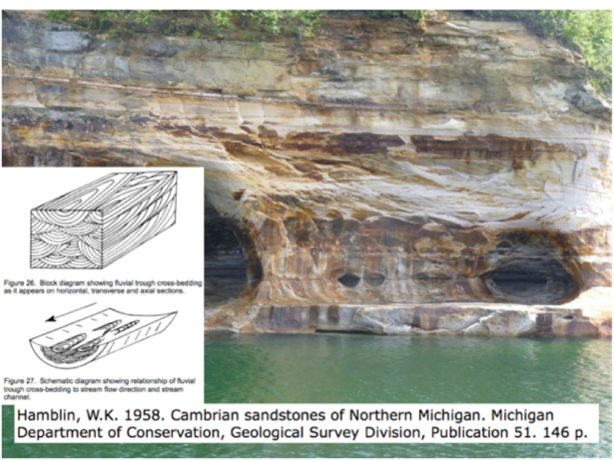Crossbedding
Crossbedding--reading the rock
What is crossbedding?
The sandstone was deposited on a nearly flat plane, but the beds below were laid down on a sloping surface, rather like brush strokes going one way and then another way on a canvas.

Cross-beds are the groups of inclined layers, and the sloping layers are known as cross strata.
Cross bedding forms on a sloping surface such as ripple marks and dunes, and allows us to interpret that the depositional environment was water or wind. Examples of these are ripples, dunes, sand waves, hummocks, bars, and deltas. Cross-bedding is widespread in three common sedimentary environments: rivers, tide-dominated coastal and marine settings.
Stats
NAME Hungarian Falls
LOCATION Hubbell, MI
KMZ download HungFallsGTour.kmz
SUBJECTS Sandstone cross-bedding
Author: Clive Wardell
What was the original environment?
In the Jacobsville Sandstone at Hungarian Falls we interpret a river. Rivers travel across the surface in quite variable styles. The river carries its heaviest and coarsest sediments in floods. Finer sediment will be carried and then laid down as the energy of the water drops below its capacity to carry the weight of heavier grains. These grains are deposited on the river bed and more are added on top over time.
During the deposition of the Jacobsville Sandstone the rivers were filling a rift valley from highlands and the deposition came in channels flowing towards the center of the rift valley (low). With rain the energy of the water running steeply downhill could be large and could carry large amounts of material! Look at the cartoon on the next page to get the whole history and placement and also try the link below to a little animation.

Here is another good example of cross-bedding from an area that is regarded as very dry, but which must have had a great deal of running water in the past!


The picture below shows that sediments are forming with cross –bedding and ripple marks today as we read these words! By knowing what environments result in modern beds we can interpret old beds.


This work was supported by National Science Foundation award #0831948.



1. The Fault 2. Dam 3. Crossbedding 4. Potholes 5. Plunge Pool 6. Bigger River? History







